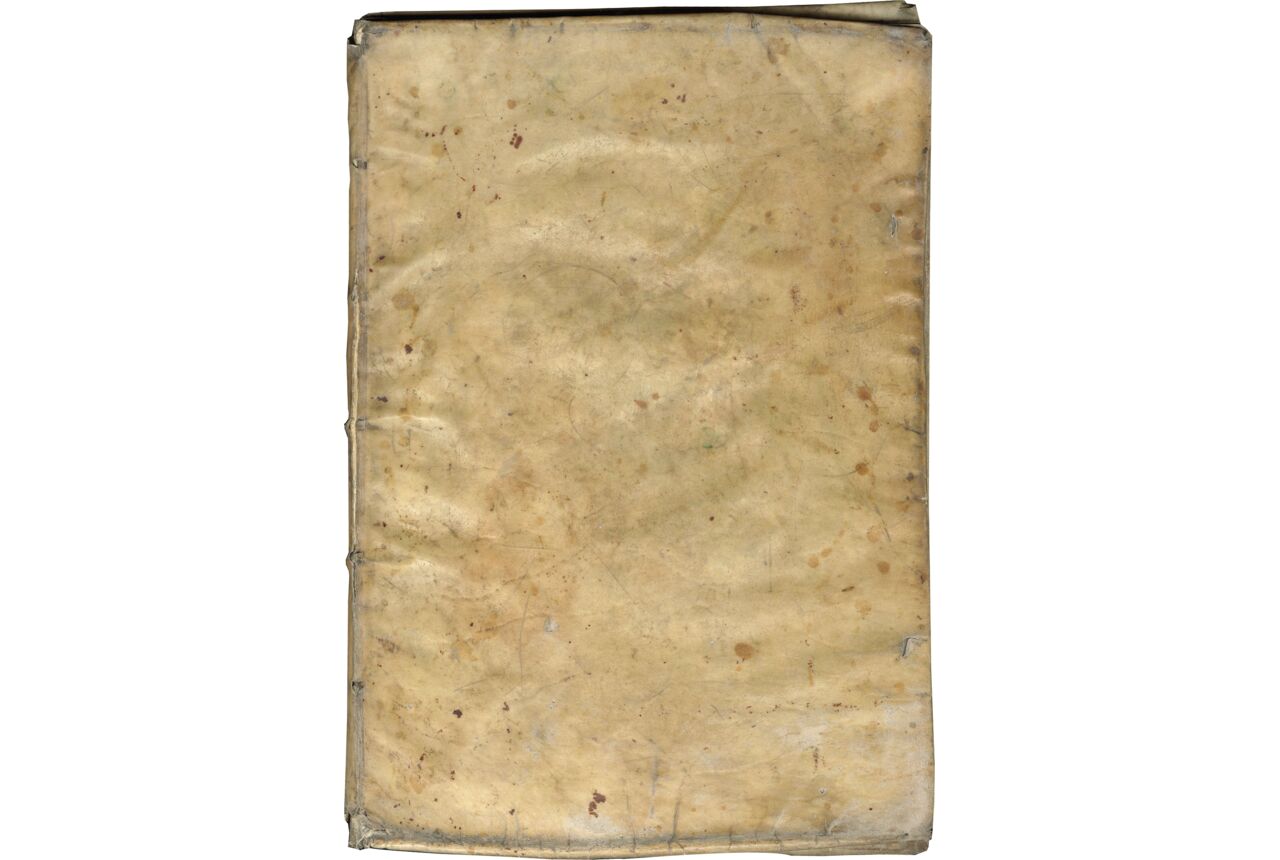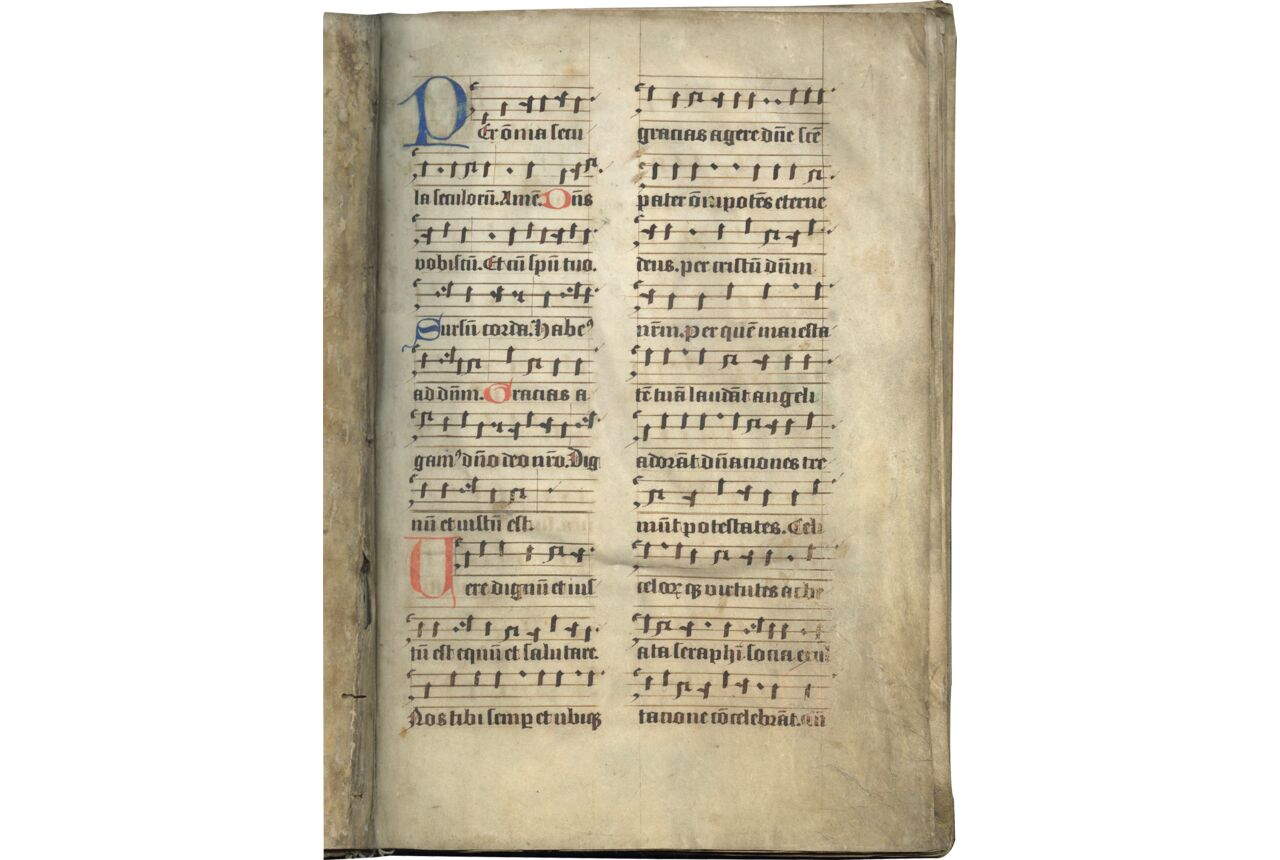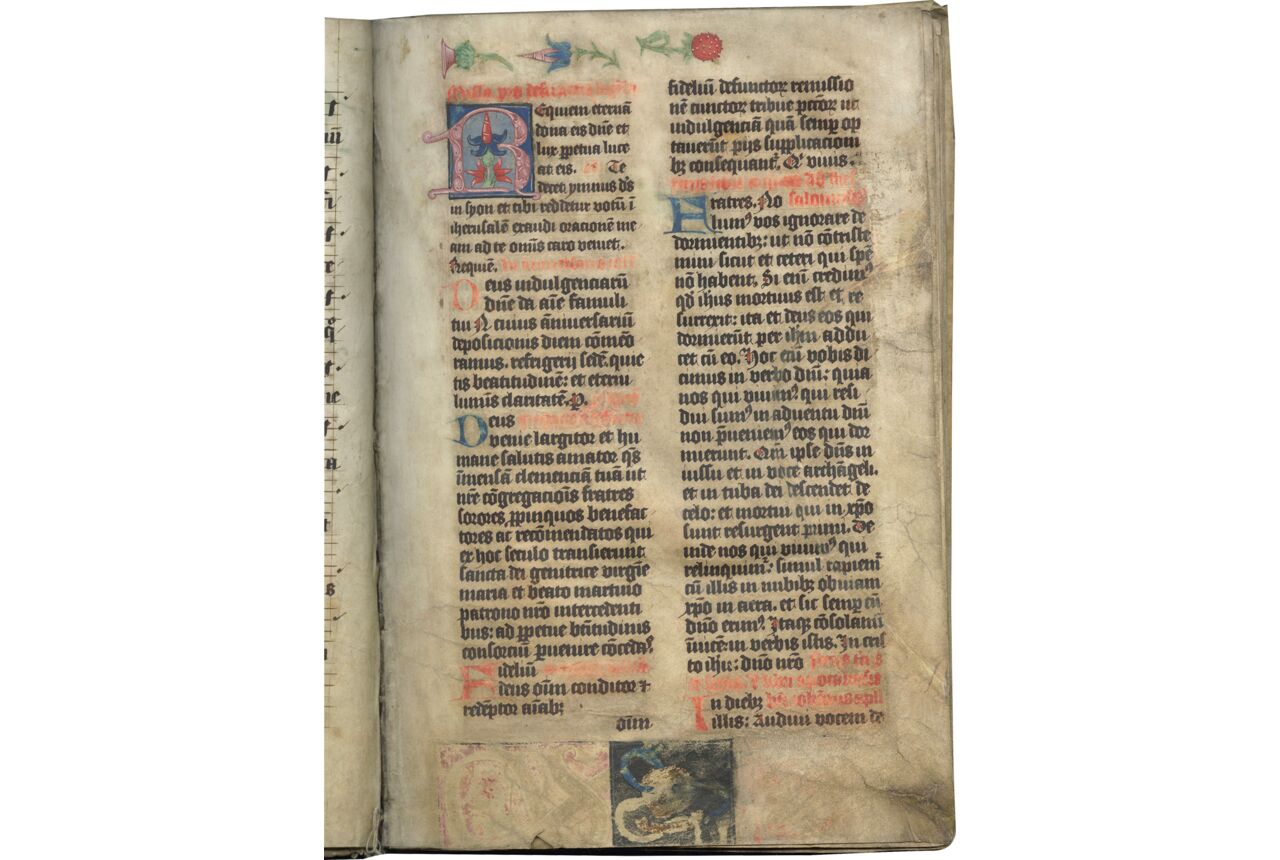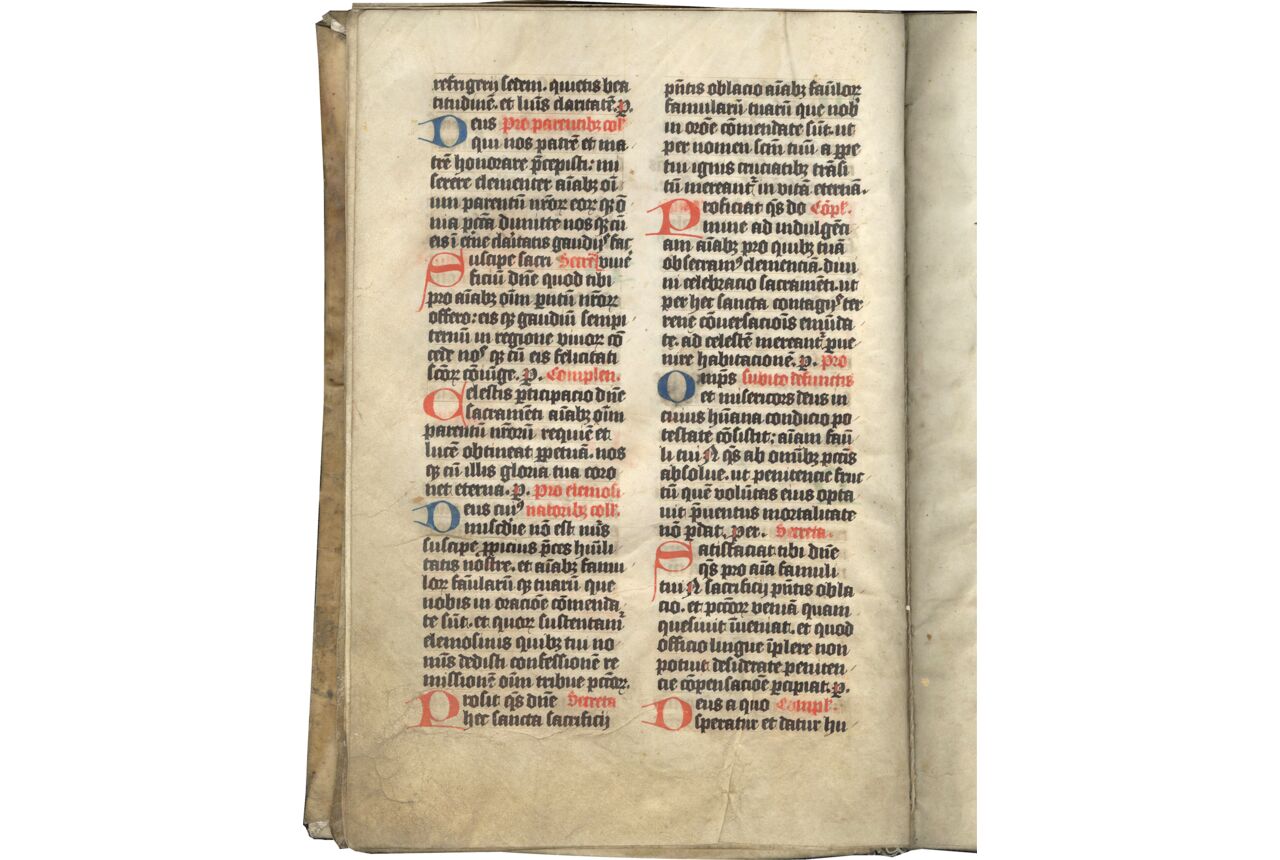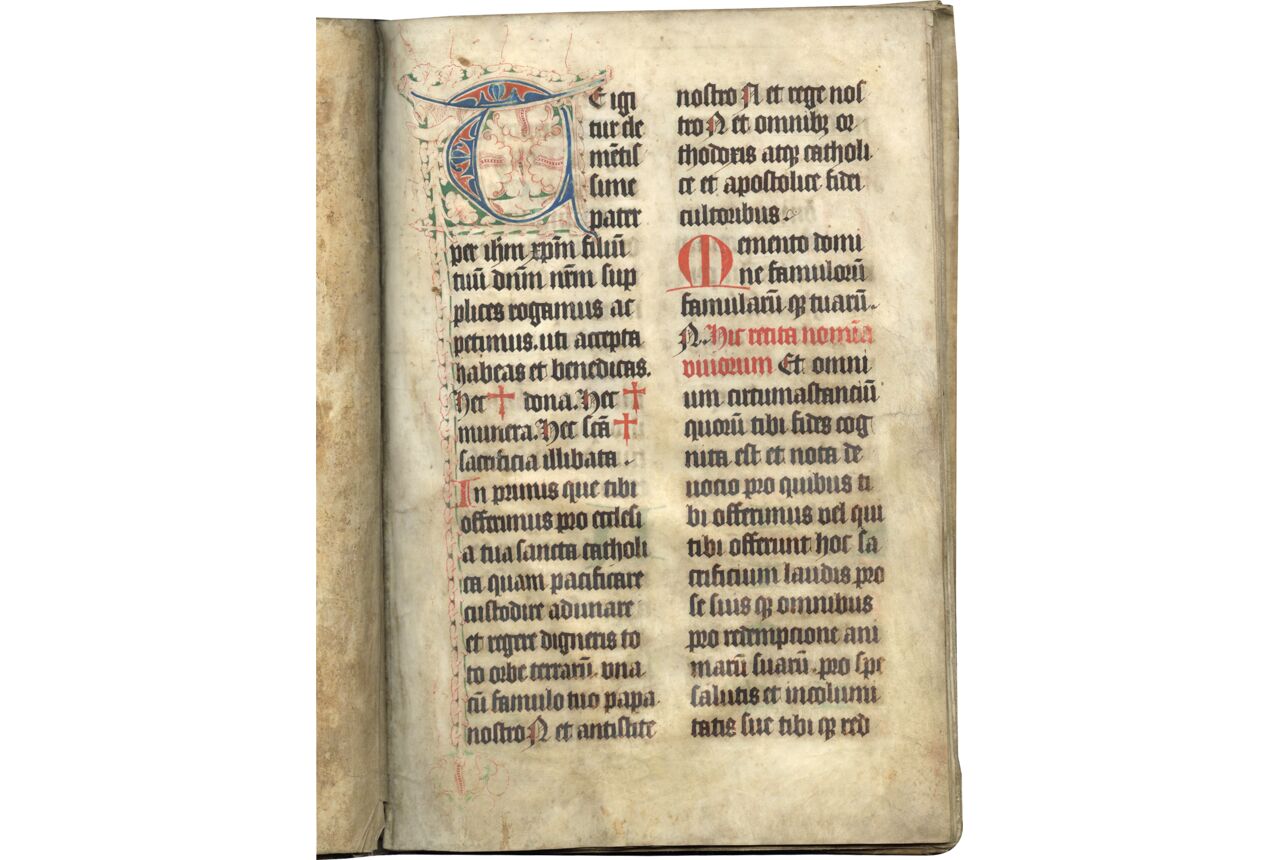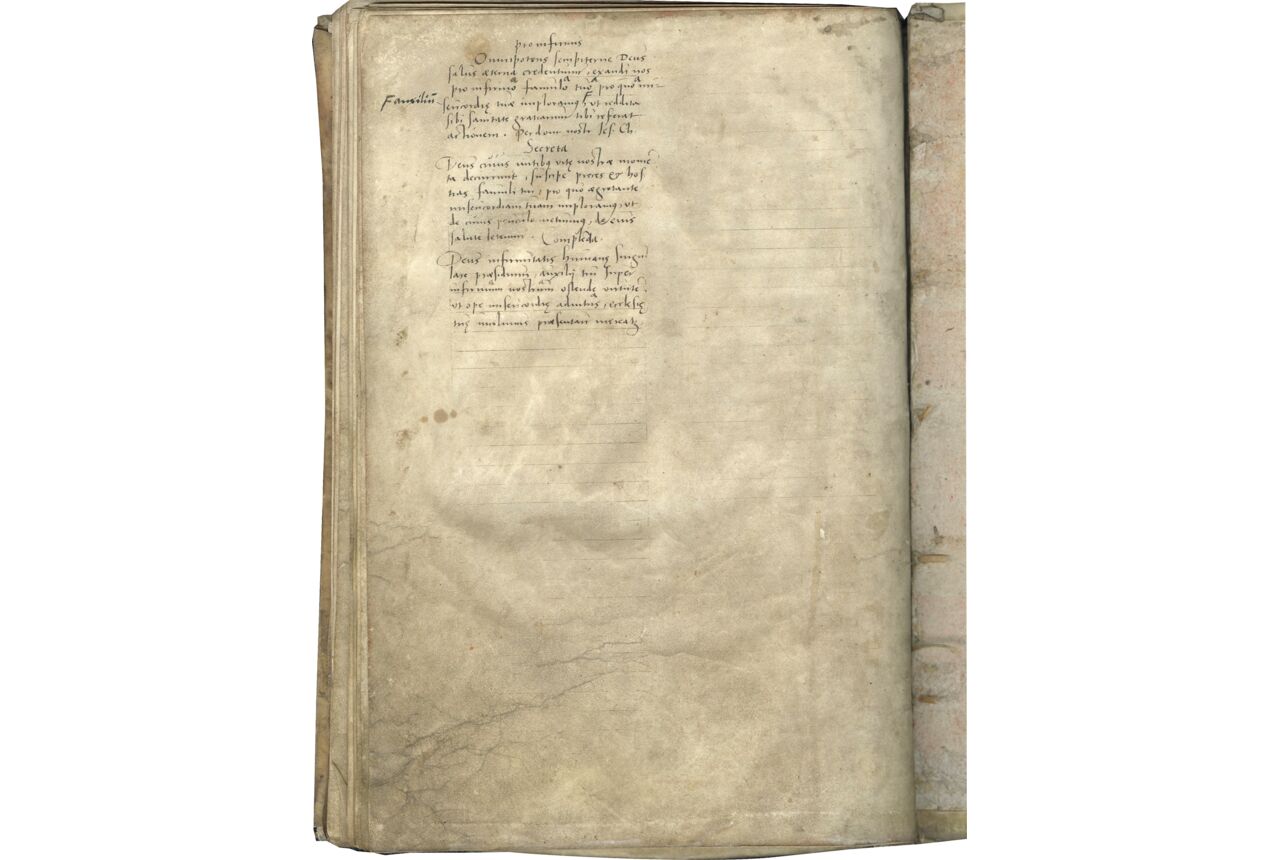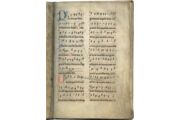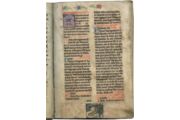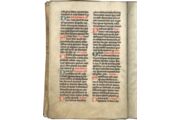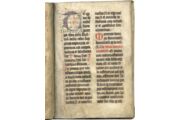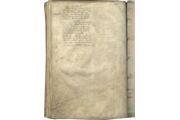i + 20 + i folios on parchment, modern foliation in pencil, upper outer rectos, complete (collation i2 ii-iii8 iv4), ruled in brown ink with full-length vertical bounding lines (justification ff. 1-1v, 241 x 155 mm., ff. 2-10, 243 x 163 mm., ff. 11-16, 245 x 160 mm., ff. 16-20v, 245 x 160 mm.), ff. 1-10, 11-20v written in Gothic textualis bookhand in black ink, ff. 11-16 written in Gothic quadrata bookhand in black ink, all texts written in two columns on 34 lines (except ff. 11-16 (Canon) with 22 lines), music in Hufnagel notation on five-line staves (ff. 1-1v, with ten staves in two columns), rubrics in red, 2-line red and blue initials throughout, two 5- to 3-line parted red and blue initials infilled and with red penwork with touches of green (initial f. 11 with penwork running length of the column), f. 2, 5-line pink initial infilled with floral motif in blue, orange and green on light blue, on a blue ground, with flowers and strawberries in upper margin and a small rectangular miniature (rubbed) of a white skull on dark blue background with a lighter blue worm protruding from skull in the lower margin, some rubrics partially rubbed off, no complete loss of text, considerable soiling and smudges from use throughout, parchment is fuzzy and floppy in earlier and later sections, heavily used but in solid condition. Bound in seventeenth-century(?) limp vellum, scratches, circular impressions and cuts on front and back covers, circled cross design on back cover in paint or stain, two slits on front and back foredge-side covers, probably for straps that are no longer extant; overall in good condition. Dimensions 312 x 215 mm.
This liturgical manuscript, notable for its formal script, musical notation, and decoration, includes texts related to death and burial. Relatively large in overall dimensions, it is nonetheless a brief codex with focused contents that could be carried easily; it may have been made for priests who served multiple parishes or small religious communities. The abundant signs of use in the manuscript are proof of its success; heavy soiling and stains and annotations and additions from the seventeenth century and later confirm that this volume remained in consistent use for centuries after its production.
Provenance
1. Evidence of the script, musical notation, and text, link are evidence that this was copied in the middle of the fifteenth century in the archdiocese of Cologne, a territory that included not only the area in present-day Germany around the city of Cologne, but also the dioceses of Utrecht and Liège in the Low Countries. The litany includes Lambert of Maastricht, Quirinus, Gereon (martyred at Cologne), and Hippolytus among the martyrs, Severinus (bishop of Cologne) and Hubert (Maastricht and Liège) among the confessors, and Ursula and Cordula among the virgins, all saints venerated within the archdiocese of Cologne. During the Middle Ages, the diocese of Utrecht was a suffragan of the archdiocese of Cologne, and there are also saints here linked particularly with Utrecht, including Willibrord (archbishop of Utrecht) and Odulph, as well as Lebuin of Deventer (a suffragan diocese of Utrecht), and Bavo of Ghent.
2. Additions in a seventeenth-century hand indicate that the manuscript remained in regular use, likely in the same community.
3. Annotations on f. 17 expanding medieval abbreviations appear to be from the eighteenth century, when readers were much less used to reading Gothic bookhands.
Text
ff. 1-1v, [Noted Preface for the Mass], “Per omnia secula seculorum. Amen. Dominus vobiscum. Et cum spiritu tuo. Sursum corda. Habemus ad dominum. … Et ne nos inducas in tentationem. Sed lib…” //
Text and music for the Preface, responsory verse, and Lord’s Prayer. The text of the Lord’s Prayer is incomplete; a note in a later section of the manuscript (f. 13v) refers the manuscript’s user back to these chants.
ff. 2-20v Missa pro defunctis [illegible], incipit “Requiem eternam dona eis domine et lux perpetua luceat eis. ….”; [followed by collects] …, [f. 11, Canon of the Mass], incipit, “Te igitur clementissime pater per ihesum Christum …; [f. 16, Prayers for Burial], Libera me domine de morte eterna in die illa tremenda….; …, [f. 19, Litany and collects], Kyrie eleyson, Christe eleyson …”; … Per omnia secula seculorum. Amen. Dominus uobiscum. Bendicamus domino.”
A complete set of texts for the Requiem Mass, including the Introit, Collect, Epistles, Gradual, Tract, Gospel, Offertory, Secrets, and the Canon of the Mass, together with the prayers for burial and a litany. Very preliminary research suggests that the texts at times follow the Use of Cologne (especially in the Offertory, Suscipe sancta trinitas on f. 9v), but also includes texts from the Use of Rome (Such as the use of Psalm 65 in the introit on f. 2). The Requiem Mass in the Use of Cologne was first printed in Cologne in 1494, while the Roman version was printed in Milan in 1474.
Although most discussions of late medieval liturgical manuscripts focus on Missals and Breviaries, the complete books for the Mass and Office, as well as the typically large-format books for the choir, Antiphonals and Graduals, this is an example of a practical liturgical manuscript with much more focused contents. Here we have the text of the Mass for the Dead (the Requiem Mass), accompanied by the prayers of the burial service. Books such as this one, including the texts necessary for one type of liturgical occasion, were less expensive than larger volumes, easy to use, and portable. Our manuscript includes some texts with musical notation, but the focus here is not on the texts that were sung; this volume focuses on the words of the liturgy.
Liturgical scholars call books such as this one that include a text, or small group of texts, pertaining to one liturgical function, liturgical libelli (literally, “little books”; see Gy, 1990, esp. pp. 111 and 120, noting that in the later Middle Ages libelli were copied for the liturgy associated with death and funerals; see also Palazzo, 1998). The services included here reflect the ritual process developed during the Middle Ages around death and burial that became a standard for Christian Europeans until the Reformation and is still followed by Catholics today.
Though there are no colophons or other obvious provenance information, this manuscript was probably produced for use by a single priest in multiple smaller parishes or perhaps religious communities. It was a manuscript that was produced with care and some expense; note the careful script and sparing, but skilled decoration. The Requiem Mass includes collects for male and female deceased, but not bishops or other priests as the full missal does (Missale Romanum/Coloniense), suggesting that the individuals who used it would never need to lead a Mass of that type. Considering the signs of repeated use, it is possible that this manuscript belonged to an itinerant priest who served several parishes or other religious communities.
Literature
Binski, Paul. Medieval Death: Ritual and Representation. Ithaca, New York, 1996.
Gray, Madeline. “Deathbed and Burial Rituals in Late Medieval Catholic Europe,” in Philip Booth and Elizabeth Tingle, eds., A Companion to Death, Burial and Remembrance in Late Medieval and Early Modern Europe c 1300-1700, Leiden, 2020, pp. 106-131.
Gy, P.-M. “Typologie et ecclésiologie des livres liturgiques médiévaux,” La Maison Dieu 121 (1975), pp. 7-21.
Gy, P.-M. “Collectaire, ritual, processional,” in La liturgie dans l’histoire, Paris, Cerf, 1990, pp. 91-126.
Plummer, John. Liturgical Manuscripts for the Mass and Divine Office, New York, 1964.
Maertens, Thierry and Louis Heuschen. Doctrine et pastorale de la liturgie de la mort, Paroisse et Liturgie 28, Bruges,1957.
Palazzo, Eric. A History of Liturgical Books from the Beginning to the Thirteenth Century, trans. Madeline Beaumont, Collegeville, MN, 1998.
Rowell, Geoffrey. The Liturgy of Christian Burial: An Introductory Survey of the Historical Development of Christian Burial Rites, London, 1977.
Online Resources
Liber Usualis
https://archive.ccwatershed.org/media/pdfs/13/08/14/14-59-32_0.pdf
Piacenza, Pietro, “Masses of Requiem,” The Catholic Encyclopedia, vol. 12, New York, 1911.
http://www.newadvent.org/cathen/12776d.htm.
Gretory Dipippo, “The Theology of the Offertory - Part 7.9 - The Uses of Cologne, Utrecht and Liège”
https://www.newliturgicalmovement.org/2015/05/the-theology-of-offertory-part-79-uses.html
TM 1315


